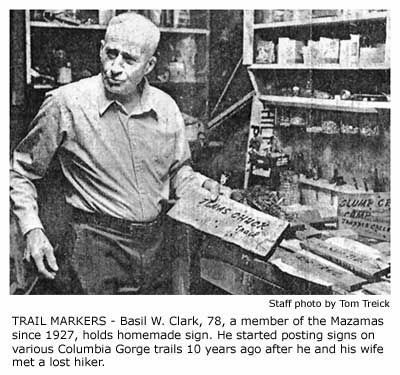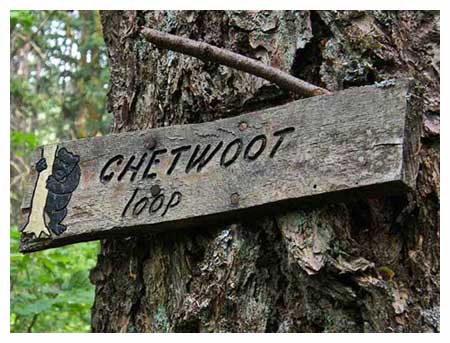Mazama creates signs that point down primrose path
Monday, July 11, 1983
By ROD PATTERSON
of The Oregonian staff
Basil W. Clark remembers the young man he and his wife, Dorothy happened upon on a trail in the Columbia River Gorge a decade ago as "that poor, lost fellow."
"He couldn't find the top of Devil's Rest, and he was standing right on it," Clark said of the young hiker who stopped the couple to ask directions.
A sign marking the spot on the trail had fallen down, Clark said. Some other trails in the gorge were unmarked or marked only marginally, a hindrance for the hiker who likes to know where he is, Clark said.
"When you're out hiking, the difference between going on the wrong trail for two miles and not going on it is the difference between success and failure," Clark, 78, said. "You get discouraged."
After the Clarks' encounter with the lost hiker, Basil Clark went home and fashioned a sign out of oak that showed a devil. He nailed it on a tree on the trail to pictorially mark Devil's Rest.
it on a tree on the trail to pictorially mark Devil's Rest.
"I hope it's still up there, but people delight in tearing these signs up," said Clark, who has gone on in his volunteer effort to make an estimated 60-some signs that direct hikers on trails in the Columbia Gorge.
Some of the signs, such as his first one, are pictorial, but most are just words that let hikers know what trail they are on, what creek they just crossed, what the elevation is and where the cutoff to a particular campsite is, Clark said.
His second sign featured a drawing of an angel to mark Angel's Rest, another high spot on the same trail as Devil's Rest.
"I started making pictorial signs, but some people were critical," he said. "The signs now are all just factual. There were some people ‑ I don't know what's the matter with them ‑ who said to just put words."
A member of the Mazamas since 1927, Clark said his pictorial signs required a little figuring out, but they told hikers where they were, such as a sun on a sign marking the Sunshine Trail.
Clark said he does not make signs that are placed in national forests.
The trail that has received most of Clark's attention lately has been the Trapper Creek Trail on the Washington side of the Columbia Gorge, "a fine place to take young kids and teach them how to camp out." Clark has erected some 30 signs in the first four miles of 'the trail.
On U.S. Forest Service property, the trail starts at the old Government Mineral Springs near Carson, Washington, and, when finished, will travel some five miles to the 3,200‑foot level. The work is being done by Mazama and Trails Club volunteers.
The trail is a priority with the Mazamas, who in 1970 became concerned about the lack of quality, low‑level trails on which to hike, Clark said,
"Now we have a trail four miles up there, mostly through the efforts of Mazama and Trails Club women. It's hard to get younger folks up to help."
Clark said the trail was not going to be marked with signs by the Forest Service, so he set about the task along with trail‑clearing and bridge‑building.
"I was just forced into making signs," Clark explained.
Although he makes the signs, Clark is quick to point out that credit should be given to many volunteers, especially to "three other good men I think I've got hooked" on the project: Kenneth Hague, Ray Davis and Virgil Velene.
"When you cross a creek, people like to know the name of It, and I also have signs pointing to campsites. The last sign I've made is for the 3,200‑foot elevation," Clark said.
Clark used to buy scraps of oak to make his signs.
"But now you have to buy boards, and I won't destroy a good board for these lousy signs," he said. Instead, he uses a wood-burning instrument on pieces of firewood. The burned-in letters are painted brown, and the sign is varnished before Clark nails it to a tree with galvanized nails.
Clark, who born in Portland, was a. service station operator in Kodiak, Alaska. He and his wife of 55 years returned to Portland in 1966 after their business was destroyed in the 1964 Alaskan earthquake and tidal wave.
"Alaska isn't all that good for trails," Dorothy Clark said. "And there are bears,- you know, Kodiak bears." Also a member of the Mazamas, she has climbed Mount Hood 40 times, she said.
The Clarks are enthusiastic about the sports of hiking and mountain climbing and would like to interest younger, stronger persons in the. activities.
More specifically, Clark is looking for younger, stronger persons to help build a bridge over a creek on the Trapper Creek Trail.
"We have to drag some felled trees over 30 feet of creek, us old 70‑year‑old men in the Mazamas," he said. "My strength is running out fast. When I walk in four miles, I'm not able to build 50 feet of trail before I have to quit. Younger people could build a couple hundred. I've got 6,000 feet of trail left to build."
When he's not hiking or building trails, Clark is either planting primroses along the path to Devil's Rest or spraying "16 gallons of poison oak discouragement" on the 'plants, along another trail.
The primroses grew out of an idea Clark had when he erected a sign showing the flower along the trail to Devil's Rest.
"You know, the way to the devil is by the primrose path," he said. When others 'expressed a desire for words-only signs, Clark responded by annually planting three primrose plants along the path.
"I hive a‑lot of fun with this," he said, adding that satisfaction comes from steering persons in the right direction.
There are so many places the public would be apt to go astray," Clark said.
Postscript: this article was kindly provided by Gerald H. Clark, son of Basil and Dorothy Clark, in response to my research on the history of the Chetwoot Loop trail in 2008. Basil's distant relative in Scotland, Stephen Butt, was also invaluable in helping me track down Gerald Clark. A print-friendly PDF version of the article can be downloaded by clicking here.
The Chetwoot Loop is a rustic path into lovely Perham Creek canyon that Basil Clark helped build in the Columbia Gorge in the 1970s. Basil's reference to "poison oak discouragement" in the above article was almost certainly in regard to this route, which happens to be in a section of the Gorge known for prolific drifts of this treacherous plant.
lovely Perham Creek canyon that Basil Clark helped build in the Columbia Gorge in the 1970s. Basil's reference to "poison oak discouragement" in the above article was almost certainly in regard to this route, which happens to be in a section of the Gorge known for prolific drifts of this treacherous plant.
As recently as July 2008, Basil's fanciful signs marking the Chetwoot Trail were still in place, and the trail still actively used by hikers.
Tom Kloster | February 2009